After the recent death of veteran Australian diplomat Richard Woolcott, Peter Job says the historical record leaves him an unquiet grave.
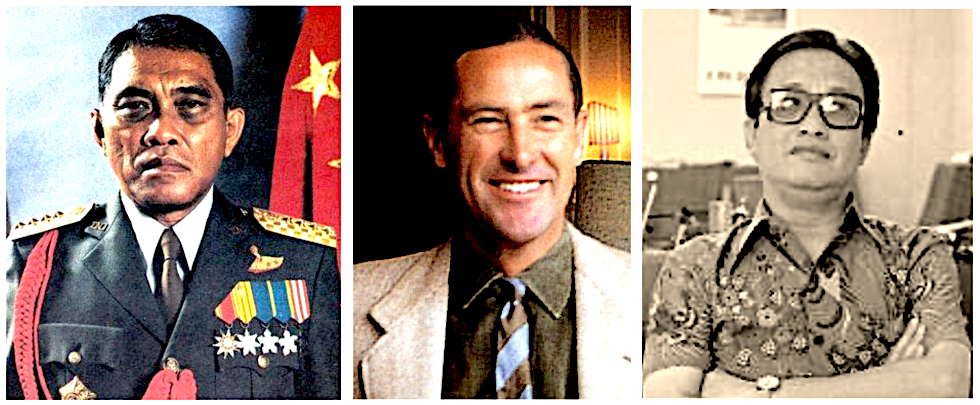
Ambassador Richard Woolcott, center, caught between his confidantes – left, General Benny Murdani, military commander of the invasion of East Timor; and right, Harry Tjan, Indonesian senior intelligence operative and military adviser. (Wikimedia, private collection, Tempo.co)
By Peter Job
Declassified Australia
 An outpouring of tributes has followed the death, at the age of 95, of former Australian diplomat Richard Woolcott. He has been described as a “class act,” as “the best Australian diplomat of a generation,” as “a giant in diplomatic circles,” as possessing “diplomatic skills as effective as Australia has ever produced.”
An outpouring of tributes has followed the death, at the age of 95, of former Australian diplomat Richard Woolcott. He has been described as a “class act,” as “the best Australian diplomat of a generation,” as “a giant in diplomatic circles,” as possessing “diplomatic skills as effective as Australia has ever produced.”
Less discussed, although well known, is the part he played in the Indonesian decision to invade East Timor, and in the subsequent early years of the occupation.
The widespread misunderstanding of his role regarding East Timor was summed up by a comment by one former diplomat who stated that, with Timor, Woolcott had “argued for acceptance of a fait accompli.”
However, far from merely accepting a course of events beyond their control, the evidence demonstrates that Australia, and Australia’s Jakarta embassy particularly under Woolcott, played a key role in enabling the course of events that led to the catastrophe of invasion and years of brutal occupation inflicted upon the Timorese people.
Perhaps the most damning piece of evidence against Woollcott is a remarkable declassified document that I located deep in the National Archive files of the Australian Department of Foreign Affairs, while researching my 2021 book, A Narrative of Denial.
The document, dated 29 August 1975, is Indonesia’s own hit list of what it suspects are “Communist agitators” to be captured “when the time comes,” and it is accompanied by four pages of allegations and erroneous details against those on it (DFA 1975b).
Titled, “Steps to Prevent Communist Agitators to Escape,” it was handed by a senior Indonesian intelligence operative Harry Tjan to Ambassador Woolcott’s most senior counsellor Allan Taylor. It was soon forwarded to the Foreign Affairs Secretary Alan Renouf, and subsequently filed.
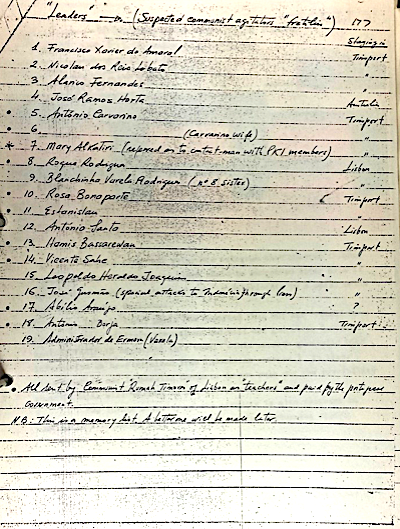
Indonesian document, page 5 – The list. (Declassified Australia)
Former Australian diplomat and consul in Dili, James Dunn, confirmed after the document was found in the archives that it was a “hit list” of Timorese leaders. “It’s not that they should be expelled from Timor, but they shouldn’t be allowed to escape,” he said. “It was, I’m afraid, a death list.”
The man who provided the list to the embassy, Harry Tjan, was one of Australia’s most trusted deep intelligence contacts within the Indonesian military-led regime. Tjan provided the “hit list” in September 1975, two and a half months before the invasion.
There is no further reference in the released archives to this “hit list” document, no evidence has been found that concerns were raised about its contents with Indonesian authorities, or even less that attempts were made to warn those targeted for death that their lives were in mortal danger.
The document is a list of 19 leading members of the East Timorese independence movement, Fretilin. Those on the list who were in Timor and who were captured in the immediate aftermath of the invasion were subsequently murdered by the Indonesian forces.
These included:
- Rosa Muki Bonaparte, secretary of the Popular Organisation of Timorese Women, executed by Indonesian forces the day after the invasion;
- Nicolau Lobato, the Fretilin leader who was killed in 1978, and his wife Isabel Lobato, though not on the list, was also killed upon her capture the day after the invasion;
- Antonio Carvarino, the Fretilin writer killed upon his capture in February 1979; and
- Maria do Ceu Carvarino, Fretilin political adviser and wife of Antonio Carvarino, disappeared soon after.

Murdered: Rosa Bonaparte, Nicolau Lobato, Isabel Lobato, Antonio Carvarino, and Maria Carvarino. (Michael Richardson, Lobato family, Carvarino family)
Australian journalist Roger East, who was hiding out in a Dili apartment with several Timorese, was captured at the same time and was also executed, at the Dili wharf.
Narrowly escaping the Indonesian net and the lethal bullets were three people who were to become central figures in the eventual independent Timor-Leste:
- José Ramos Horta, the current president of Timor-Leste, who had been sent to Australia just prior to the invasion;
- Mari Alkatiri, Timor-Leste’s first prime minister, who at the time was delegated to Mozambique; and
- Xanana Gusmão, who had retreated to the mountains and who became the nation’s key resistance leader and, after the restoration of independence in 2002, Timor-Leste’s first president.
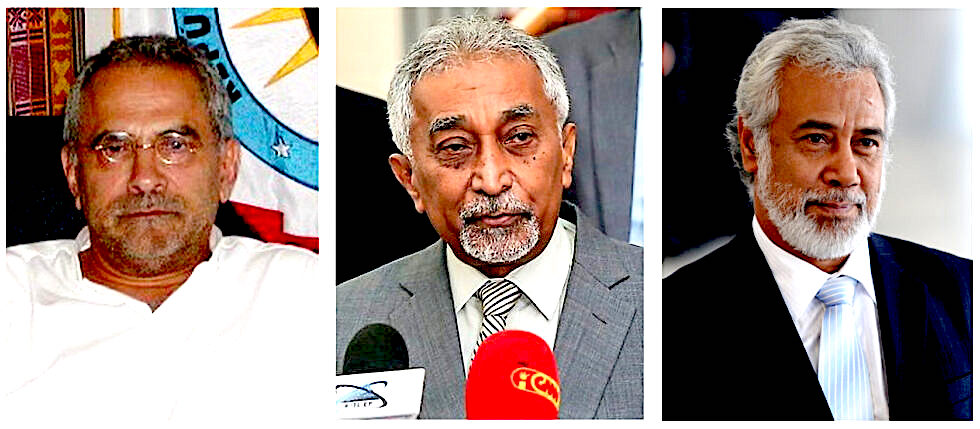
Escaped: President José Ramos Horta, ex-President Mari Alkatiri, and ex-President Xanana Gusmão. (Jeffrey Kingston, Juliao Fernandes, Antonio Cruz /Collective Commons)
Woolcott stayed on as Australia’s ambassador in Jakarta until 1978. This was the period in which the Indonesian military conducted brutal “sweeping” military operations against the Timorese population, and it was the start of a forced famine in the rural areas that would kill as many as 180,000 civilians over three years.
This has been previously documented, recently by Declassified Australia, in an article titled “Blood in the Archives.”
Woolcott would go on to have an illustrious career becoming Australia’s ambassador to the United Nations in 1982, before being promoted to the top of the foreign affairs tree, as departmental secretary serving from 1988 until 1992.
Allan Taylor too would go on to an eminent career, culminating as director of the overseas spy agency, the Australian Secret Intelligence Service (ASIS), from 1998 to 2003. (Of note, Taylor was replaced at ASIS by another Jakarta embassy old hand, David Irvine, who was later in charge of Australia’s 2004 Timor bugging operation.)
The “hit list” document, and the response to it by Woolcott and other Australian officials, tells a story of how smart and confident Australian diplomats were caught up in a web, compromised by their collaboration with Indonesian actions aimed at undermining the Timorese decolonisation process and ultimately compelling integration by brutal force.
Prime Minister’s Messenger
Prime Minister Gough Whitlam sent his private secretary Peter Wilenski to Indonesia to confer with Tjan in June 1974. According to both Indonesian (Wanandi 2012, 195) and Australian sources, Wilenski told Tjan that Whitlam believed East Timorese independence to be unviable, and that it should be non-violently incorporated into Indonesia.

(Peter Fitzgerald, CC BY-SA 4.0, Wikimedia Commons)
This approach was also endorsed by Woolcott, who was yet to be appointed ambassador.
However it was this Whitlam-initiated meeting that inspired Tjan to submit a proposal to Suharto advocating an operation to force integration. An embassy cable to Canberra of 3 July 1974 states: “It was after talking with Wilenski that it occurred to Tjan that there might well be scope for more than a diplomatic initiative alone.”
Tjan then approached the Australian embassy to inform them of Operation Komodo, a clandestine operation by armed guerrillas and undercover spies to infiltrate East Timor and undermine independence moves. Tjan set out to the Australians that Australia’s role should be to “neutralize” international objections to an Indonesian takeover.
What followed was a long series of Indonesian intelligence briefings to the Australian embassy outlining Indonesia’s increasing clandestine activities that ensured Australia was implicated in the Indonesian plans. The briefings detailed the training of forces aimed at destabilising East Timor and producing a pretext for an Indonesian takeover. The Australian government had been implicated and entangled.
Woolcott Supports Indonesian Position
As head of Public Affairs in the Department of Foreign Affairs through the early 1970s before becoming ambassador, Woolcott had worked to brief the media and foreign officials, and distribute materials supporting the Indonesian position on Portuguese Timor.
This included supervising a secret propaganda unit inside the Political and Social Research Section of Department of Foreign Affairs (DFA), as Declassified Australia has previously exclusively revealed.
On assuming the ambassadorship in March 1975, Woolcott worked stridently to support the Indonesian position. Declassified embassy cables show he emphasised to Canberra the supposed risk an independent East Timor would pose to Indonesian security, the determination of Indonesia to incorporate the territory and the importance to the Australian national interest in supporting this position.
Woolcott gained details of the secret Indonesian invasion plan from regular meetings with senior intelligence official General Ali Murtopo, Foreign Minister Adam Malik and the military dictator of Indonesia, President Suharto, and through briefings by Tjan and others to his subordinates.
The documents show, for example, in June 1975 Woolcott reported to Foreign Minister Willesee that “Indonesia’s covert activities in Portuguese Timor will be stepped up…. .‘Refugees’ are being prepared at Atambua to return to Portuguese Timor to play their part.”
On 10 July 1975, Woolcott was informed by Tjan that, “The blueprint of Indonesia’s plan’ had been worked out, including the prospect of, ‘armed intervention…without provocation.’”
The archival record so far released contains no evidence that anyone from the prime minister down expressed any concern to the Indonesians.

(J. Patrick Fischer, CC BY-SA 3.0, Wikimedia Commons)
Part of the Indonesian plan was to secretly orchestrate a coup in August 1975 by the conservative Timorese UDT party. Fighting lasted several weeks and over 1,000 Timorese were killed. But the coup failed and Fretilin took control of the territory in early September.
It is clear from the archives that at that time Woolcott was also aware of the tremendous oil and gas resource that was at stake below the bed of the Timor Sea.
In August 1975, he cabled Canberra:
“I wonder whether the department has ascertained the interest of the minister of the Department of Minerals and Energy… . This department might well have an interest in closing the present gap in the agreed sea border and this could be much more readily negotiated with Indonesia… than with Portugal or independent Portuguese Timor.”
After the failed coup attempt, Indonesia’s enhanced covert military campaign, Operation Flamboyan, was launched from Indonesian West Timor and consisting of mostly Indonesian soldiers disguised as Timorese. They were instructed to create “terror and intimidation” (CAVR 2013, 188-189).
Australian journalist Roger East, himself later captured and killed by Indonesian troops, reported in early November 1975 that an Indonesian attack at Atsabe inside East Timor had killed 30 Timorese villagers (East 1998, 25-30).
Indonesian intelligence kept the Jakarta embassy well informed. On Sept. 3, Woolcott informed Canberra that, “We now have from… Tjan a detailed account of Indonesia’s planning’ including Indonesian ‘volunteers and arms,’ and efforts ‘to cut off food supplies.’”
On 30 September 1975 Tjan informed the Australian embassy that, “up to 3,800 Indonesian soldiers from Java would be put into Portuguese Timor gradually.”
While this was underway, the Australian government was constructing a narrative of lies about the growing steps towards self-determination of the East Timorese. The Australian public heard a different story.
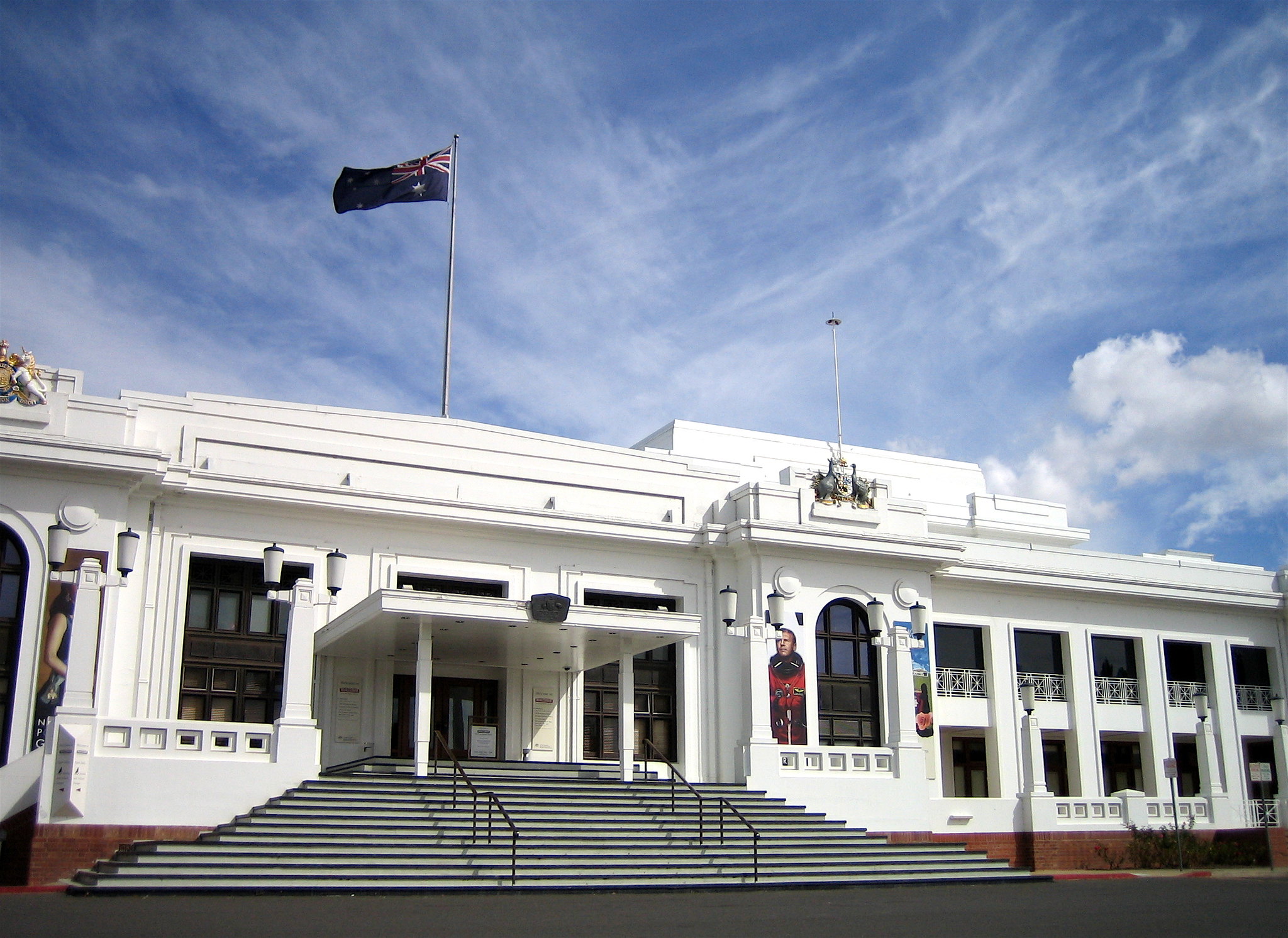
Australia’s former Parliament House, 1927 to 1988, in Canberra. (Justin Knol, Flickr, CC BY-NC 2.0)
On 26 August 1975 Whitlam assured Parliament that, “Indonesian policy is to respect the right of the people of Portuguese Timor to self-determination.” He stated on 18 September that Suharto was “strongly committed to a process of peaceful decolonization” and that “Indonesia has exercised considerable restraint” (DFA 1975a).
Through their acquiescence, the Australians including Ambassador Woolcott, effectively provided their assent to the Indonesian policy. Through disinformation they effectively became propagandists for the blood-thirsty faction in the Suharto regime working most stridently to undermine the Timorese decolonisation process through subversion and violence.
On 13 October the Jakarta Embassy Minister Malcolm Dan cabled Canberra details of a forthcoming major military assault to capture the East Timorese towns of Balibo, Maliana and Atsabe (DFA 1975c).

Early warning sent to Canberra three days before the journalists were murdered in Balibo. These excerpts from a Secret cable from the Jakarta Embassy to Canberra of 13 October 1975 passes on details from Indonesian intelligence about the forthcoming Indonesian military assault across the East Timor border on several towns including Balibo.
In 2007 a Coronial Inquest was held in Sydney into the death of one of the journalists murdered by Indonesian clandestine forces in Balibo, cameraman Brian Peters. It established the five Australian-based journalists were killed by Indonesian Special forces in Balibo on 16 October 1975 on the orders of Major General Benny Murdani.
The Inquest also revealed Ambassador Woolcott dined with his close confidante General Murdani on the evening of 15 October, just hours before the fateful Balibo attack. At the dinner, Woolcott was further informed about the impending attack, although no evidence has been found that Woolcott was aware of the presence of the journalists. He was, however, fully aware that Timorese would die in the attack.
Roger East’s First Report
After the Indonesians attacked Balibo, the deaths were quickly becoming public. Roger East published the first report from an eyewitness directly blaming the killings on the Indonesian forces. But for the Australians, the key concern was that the killings could “inflame Australian public opinion” against Indonesia.
Woollcott had been caught, willingly or otherwise, in a classic case of collusion leading to compromise. The Indonesian intelligence agencies, having learnt well from their Dutch and Japanese predecessors, had become the experts of drawing people into a spider’s web of trust and deceit, compromise and obligation.
Woolcott may have even recognised the trap. He complained, “we are too well informed as a result of the confidence shown us by Tjan and Murdani” and that making representations to Jakarta could place them in a difficult situation.
Protecting Indonesian intelligence and the Suharto regime became the priority. Partly because Australia wanted to support the Indonesian actions against an independent Timor, and partly as they saw the need to hide their past collusion with the invasion planners. The two reasons became intertwined — it became impossible to see a separation.
Tjan’s purpose in providing the “hit list” was an attempt, and a successful one, of procuring Australian complicity in the undermining of the Timorese decolonisation process through subversion and violence.

Traditionally dressed Timorese during celebrations in 2010 for the 35th anniversary of their country’s 1975 proclamation of independence from Portugal, in Dili, East Timor. (U.N. Photo/Martine Perret)
Some within the Department of Foreign Affairs noted that Indonesian intelligence had provided the briefings in order to constrain and compromise Australian policy. Geoffrey Miller of the Indonesian Section in Canberra commented that, “The Indonesians have, shrewdly, compromised us by making sure that we know their plans for covert intervention in some detail.”
Woolcott later tried to absolve the Indonesians and blame the journalists for their own deaths, when he wrote that “the journalists had identified themselves with one side” and “should not have been where they were” (Woolcott 2003, 154). So far did he come to identity with Indonesian objectives, that he saw any attempt to expose the illegal and lethal assaults as partisan and illegitimate.
Aligned with the Woolcott position, government investigations of what happened in Timor and of the deaths of the journalists, became artifices of denial in the following months, years and decades.
But the support for the hardliners and for the invasion was not universal within the Indonesia administration. The moderate Indonesian Foreign Minister Adam Malik initially supported a position accepting of East Timorese independence (Job 2021, 18-21).
With evidence that Suharto was initially reluctant to authorise force, Australia initially had the option to work with Indonesia towards orderly decolonisation. Instead, Australia intervened in Indonesian factional politics in support of the hardliners, marginalising the moderates and the alternative pathway they offered.

Aerial view near Dili, East Timor. (U.N. Photo/Martine Perret)
Furthermore, far from being brilliant as a report by the ASPI think tank bizarrely suggested, much of the analysis of the Australian embassy during this time was poor. It allowed Indonesian intelligence to mislead it about the position of Foreign Minister Malik, claiming he was a hardliner on East Timor, when in fact he supported a moderate approach (Job 2021, 18-210).
Woolcott maintained to Canberra that Fretilin represented a small elite and that the possibility of guerrilla resistance “cannot be taken seriously” (DFA 1975a), a position indicative of the woefully inadequate intelligence, indeed indifference, concerning the situation in East Timor itself.
Fretilin Changed Tack
After almost three months of unsuccessfully calling for a Portuguese return, and international assistance for a decolonisation process, and with an Indonesian invasion force readying, Fretilin changed tack and in a last desperate effort to gain international recognition to stave off the invasion, issued a Unilateral Declaration of Independence on 28 November 1975.
After a meeting in Jakarta between U.S. President Gerald Ford, Secretary of State Henry Kissinger and President Suharto where the U.S. gave tacit approval for the invasion, Indonesia invaded the next day, on 7 December, commencing a brutal 24-year occupation that would leave up to a third of the population dead.
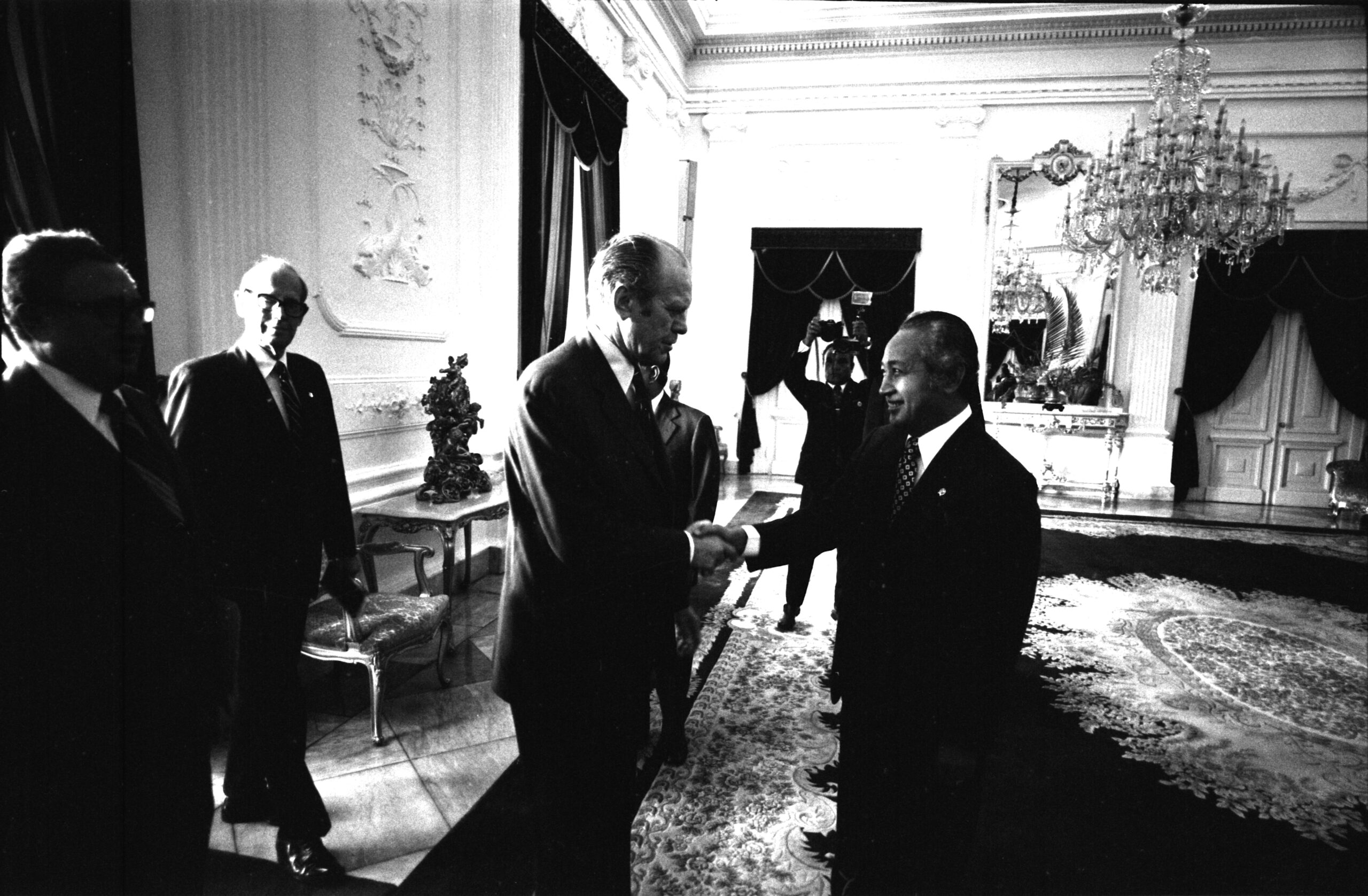
Dec. 6, 1975: Indonesia’s General Suharto, on right, shaking hands with U.S. President Gerald R. Ford in Jakarta. U.S. Secretary of State Henry Kissinger on left. (David Hume Kennerly, – Courtesy Gerald R. Ford Presidential Library, Public domain, Wikimedia Commons)
Woolcott notified Canberra of the invasion the day before it occurred. He emphasised that Indonesia would be looking to Australia “to blunt the further growth of anti-Indonesian feeling.”
He made recommendations about how the situation should be spun to the public, anticipating the false narrative Australia would propagate to the world in the following years.
Far from merely accepting a fait accompli, the Australian government empowered the Indonesian hardliners, producing an invasion that probably would not otherwise have happened.
As evidence mounted of a dire situation after the invasion, Woolcott worked to discredit it.
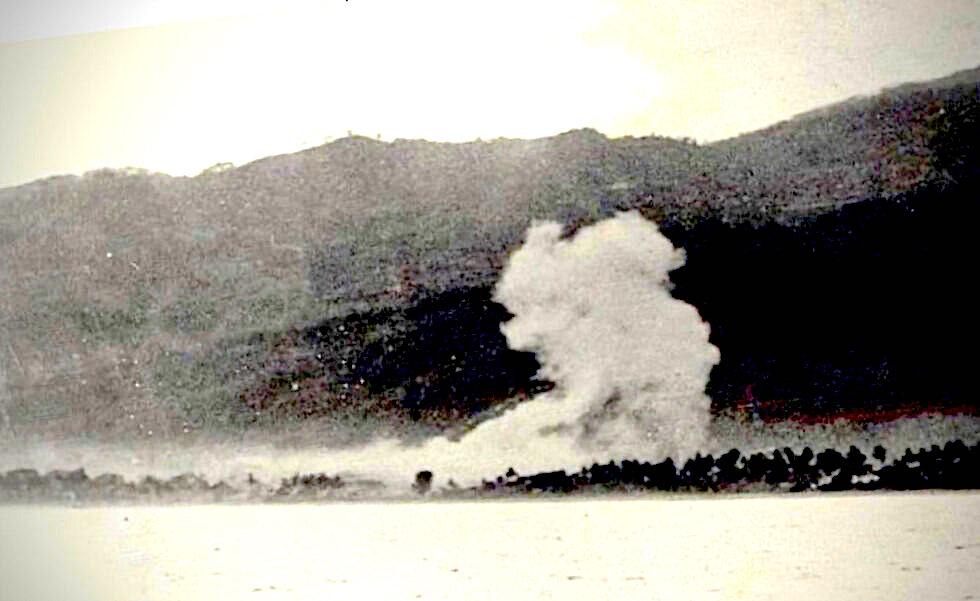
East Timor’s capital Dili on the morning of the military invasion, seen from an Indonesian warship, smoke rising high behind the historic Motael Church on the waterfront. The Indonesian operation was planned as a pincer movement from the east and the west of the city to cut off and capture the Timorese leadership, their names listed in the Indonesian ‘hit list’ delivered to Australia’s Jakarta embassy two months before the invasion. Their aim was only partly successful – some of the targeted Timorese were captured and executed, but some escaped. (Timorese Resistance Archive & Museum)
Accounts of severe human rights abuses, including massacres, sexual violence, deliberately induced famine and a very high death toll, were collected in a report by parliamentary researcher and former intelligence and foreign affairs officer James Dunn in early 1977.
Woolcott dismissed his findings as “hearsay’, accused Dunn of “stir[ring] up hostility towards Indonesia in third countries of importance to them.”
Woolcott even argued that as a government employee it was the government’s duty to constrain him (DFA 1977).
Woolcott continued to have “a brilliant career.” He was Foreign Minister Gareth Evans’ department head when Gareth signed the Timor Gap Treaty with Indonesian Foreign Minister Ali Alatas, in a plane over the Timor Sea, grabbing the lion’s share for Australia.
Into his retirement Woolcott argued that Australians who campaigned for independence and against human rights abuses in East Timor were “racist” and “anti-Indonesian” for supporting “a lost cause which raises false hopes, prolongs conflict and costs lives.” He argued against independence for East Timor saying in 1999 that there could be “substantial financial implications” if the Timor Gap Treaty unraveled.
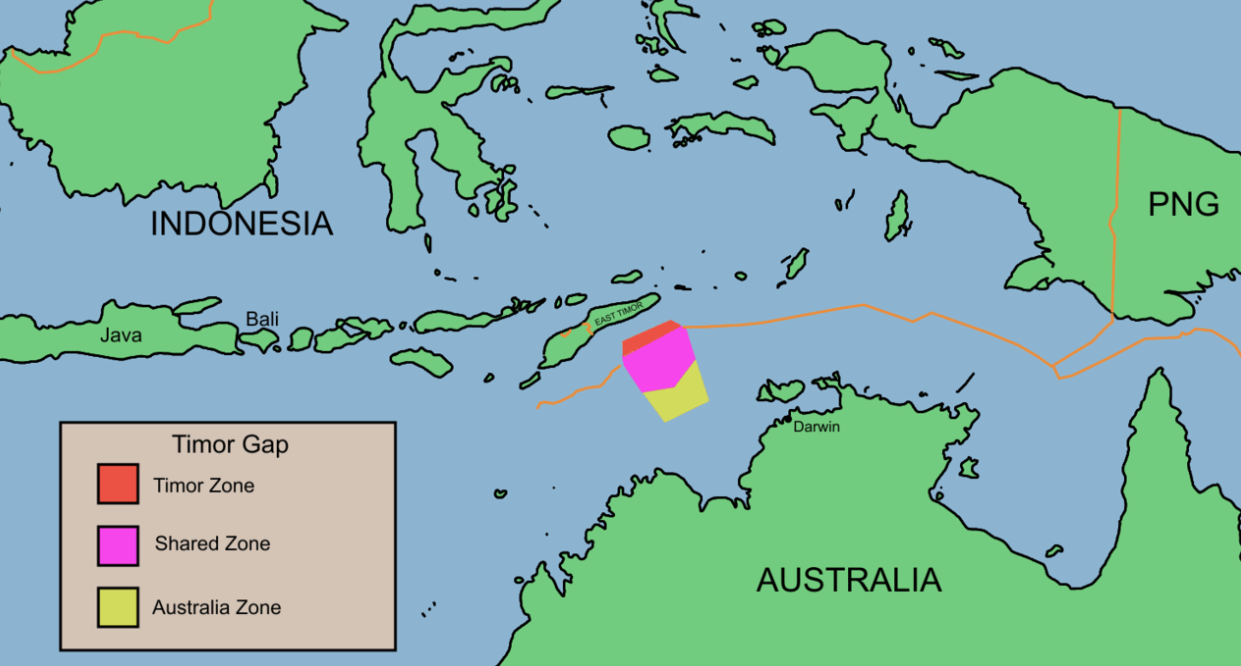
(Roke, CC BY-SA 3.0, Wikimedia Commons)
In the Mainstream
Woolcott later pointed out that his position was essentially the same as the ambassadors who both proceeded and followed him. Indeed, far from being a dissident or a stand-out, Woolcott’s position was entirely mainstream. The secret Indonesian briefings on Timor had commenced under Ambassador Furlonger, Woolcott’s predecessor.
Ambassador Critchley, who succeeded Woolcott in 1978, worked stridently to defend the Suharto regime, cabling to Canberra recommendations about how the ongoing crisis should be framed to deny evidence of atrocities and widespread starvation as Indonesia implemented its program of encirclement and annihilation against Timorese resistance. This was recently described in an article in Declassified Australia.
As I detail in my book, A Narrative of Denial, in the following decades of occupation the Australian government was the most proactive defender of the Indonesian position in East Timor, denying evidence of abuses, and supplying military aid, some of it used in East Timor.

A Narrative of Denial: Australia and the Indonesian violation of East Timor is informed by hundreds of hours of research, by the author Peter Job, amongst the declassified government files held by the National Archives of Australia, in leafy Canberra. (National Capital Authority)
This was accompanied by a juggernaut of propaganda in defence of the occupation from politicians, government officials, journalists and academics. Australian lobbying at the U.N. had a profound effect, not only delaying a long-term solution but also shorter-term measures to alleviate suffering, including the entrance of aid.
Australia’s actions can be understood in the context of how Australia viewed itself, the regional defender of the Western status quo, what academic Clinton Fernandes describes as the purveyor of sub-imperial power. This subservient role to the U.S. has been recently described in Declassified Australia.
The Suharto regime, having brutally suppressed the Indonesian Communist Party in the 1960s, was viewed as anchoring a certain kind of stability in the region, one supportive of U.S., Australian and Western strategic goals and favourable to Western economic interests.
The issue of Timor Sea resources added another dimension to this. The rights and suffering of the Timorese people were incidental to such a worldview.
Australian malevolence towards the Timorese people continued after independence with the bugging of the Timorese cabinet room to gain an unfair advantage in seabed boundary and resource negotiations; and the subsequent theft of hundreds of millions of dollars of Timor Sea resources.
There is a strong argument for recompense and an apology by the Australian Parliament for the role the nation played in the catastrophe inflicted upon the Timorese people.
—
References:
CAVR. (Comissão de Acolhimento, Verdade, e Reconciliac?ão Timor Leste). Chega! Dili: CAVR, 2013.
DFA 1975a. NAA: A10463, 801/13/11/1, xiv. Whitlam, Gough 1975, Letter from Whitlam to Bob Bolger, Secretary, Waterside Workers Federation of Australia, 18 September 1975.
DFA 1975b. NAA: A10463, 801/13/11/1, xiv. Portuguese Timor. Letter from Taylor to Renouf, 23 September 1975. Attachment.
DFA 1975c. NAA: A10463, 801/13/11/1, xv. Cable from Jakarta to Canberra. Portuguese Timor. 13 October 1975.
DFA 1977. NAA: A10463 801/13/11/10, i. Memorandum from Woolcott to Parkinson. 9 March 1977.
East, Roger. ‘East Timor’s border war’, in Jim Aubrey (ed.), Free East Timor: Australia’s Culpability in East Timor’s Genocide. Sydney: Random House, 1998.
Job, Peter. A Narrative of Denial: Australia and the Indonesian violation of East Timor. Melbourne: Melbourne University Press, 2021.
Richardson, Michael. ‘The secret story of the road to war in Timor’, National Times, 19–24 July 1976.
Wanandi, Jusuf. Shades of Grey: A Political Memoir of Modern Indonesia. Jakarta: Equinox Publishing, 2012.
Woolcott, Richard. The Hot Seat: Reflections on Diplomacy from Stalin’s Death to the Bali Bombings. Sydney: HarperCollins, 2003.
—
* Additional research by Peter Cronau.
Peter Job helped run a clandestine radio network in northern Australia in 1978 receiving messages from Fretilin inside East Timor, including about the forced famine. Peter has now completed a PhD in international and political studies from the University of New South Wales in Canberra. His new book, A Narrative of Denial: Australia and the Indonesian Violation of East Timor, was published by Melbourne University Publishing in 2021. He is on Twitter @JobPeterjob1. View all posts on Declassified Australia by Peter Job.
This article is from Declassified Australia.
The views expressed are solely those of the author and may or may not reflect those of Consortium News.

I had only inquired about Allan Nairn here 2 days ago, because he covered this topic in the 1990s together with Amy Goodman.
Before East Timor´s independence 1999 Nairn was imprisoned by the Indonesian Army.
I remember that back then I was acquainted with a guy whose parents had business relations with President Habibie who followed Suharto after latter resigned in 1998.
While Nairn in prison I was dragging my feet to reach out to the parents with the rather naive hope they could put in a word for the imprisoned Nairn.
(Just then I drafted my final high school paper about East Timor. The research for the paper included an Australian documentary. I am not sure whether it was “Punitive Damage”. Though I have a different name in mind than Annie Goldson, instead a appr. “(C)Katherine Keen” (?). Anyway. It did cover the story of Kamal Bamadhaj. And it did have extensive interviews with Nairn. So I was in the subject constantly…think high school idealism.)
Unfortunately I had never met the parents personally and so contact wouldn´t materialize.
For some time I felt responsible for not trying harder to “help” Nairn.
Eventually Nairn got out.
But the situation was volatile right after he was imprisoned.
And now I have the impression Nairn had a bit disappeared from public lately.
“After a meeting in Jakarta between U.S. President Gerald Ford, Secretary of State Henry Kissinger and President Suharto where the U.S. gave tacit approval for the invasion, Indonesia invaded the next day, on 7 December, commencing a brutal 24-year occupation that would leave up to a third of the population dead.”
I read about a dozen obituaries of Gerald Ford at the time of his death but none chose to mention this. If I remember correctly, it only got mentioned by one newspaper because a reader wrote in about it.
does anyone have news on Alain Nairn?
Alain Nairn has on many occasions been a guest of Amy Goodman’s ‘Democracy Now.’ Amy Goodman was with Alain Nairn when both were reporting on East Timor, sometime back in the 1990’s. Both he and Goodman were brutally attacked as they sought truth regarding the events in that region. Their visit to East Timor occurred shortly after the deaths of three Australian reporters. You could try DemocracyNow.org to search its site of all of Goodman’s shows.
I had great admiration for Alain Nairn until he, as a guest on Democracy Now, bullied Julian Assange during an interview Amy Goodman aired with Julian Assange while locked-up inside Ecuador’s Embassy in London. Alain Nairn blamed Assange’s Wikileaks release for giving America the Trump Presidency. It was beneath Nairn, and it made me less of a regular viewer of Democracy Now.
Woolcott in the late 90s or so asked to meet Jose Gusmao a key activist in Darwin for East Timor. I tried to persuade Jose not to go alone, but he did. Woolcott told him he was the first East Timorese he had met!
(Maybe the first alive Timorese!!) Congrats to Peter Job for his persistence and hard work. Now to get more cash flow in East Timor before its too late. Wes
Thanks Wes. In my archival research on the period leading up to the invasion there is very little evidence of any serious attempt to evaluate or understand the situation in East Timor itself. The Indonesian briefings were accepted without proper evaluation, but it was as if the situation in East Timor itself was not considered an important factor in decision making. Woolcott’s assessment that there would be no sustained resistance after the invasion is a sign of this. He, the Jakarta embassy and the Australian government’s intelligence was poor and they failed to engage in due diligence regarding the unfolding situation. The consequences for the people of East Timor themselves of Australian policy was hardly a policy consideration at all.
Thank you, Peter Job, for this and for your outstanding work during East Timor’s epic struggle. Richard Woolcott was a classic ambassador-for-the-other side: in this case Suharto’s genocidal regime. In an interview in 1994, he told me that the heroic Balibo journalists effectively caused their own murders. He could barely contain his anger at their memory. Woolcott was an authentic representative of a class of Australians who were ‘little Anglo-Americans’. They are as powerful and dangerous as ever.
Thanks John. Interesting, but not surprising. He repeated the claim in his biography that the journalists “should not have been where they were”, were biased towards what he considered an illegitimate entity (Fretilin) by doing so, and were thereby responsible for their own deaths. It is worth pointing out that at the time the journalists died Fretilin were only reluctantly in power and were calling for a Portuguese return to continue what the called “orderly decolonisation”. Woolcott appears to have been completely myopic about the fact that he and the embassy he led was deeply implicated in what was an illegal and lethal assault on the Timorese people. So far did he come to identify with the goals of the Indonesian hardliners that he came to see their murderous activities as legitimate and the resistance to them as illegitimate. Of course, in this he was hardly alone. As you are aware throughout the occupation the Australian government and most of the Australian media took a similar approach. Those that bucked that trend and reported the truth, such as yourself, were a minority.
Colonialism must die. That is all.
Disgusting! What little-else can one say about people who choose to go-along with organized killings of 10’s or 100’s of THOUSANDS of innocents — even though they could perhaps have prevented it — just to ensure their sinecure and rub elbows with fellow genociders like Kissinger, and be able to attend gala functions, and be among the ’elite’…